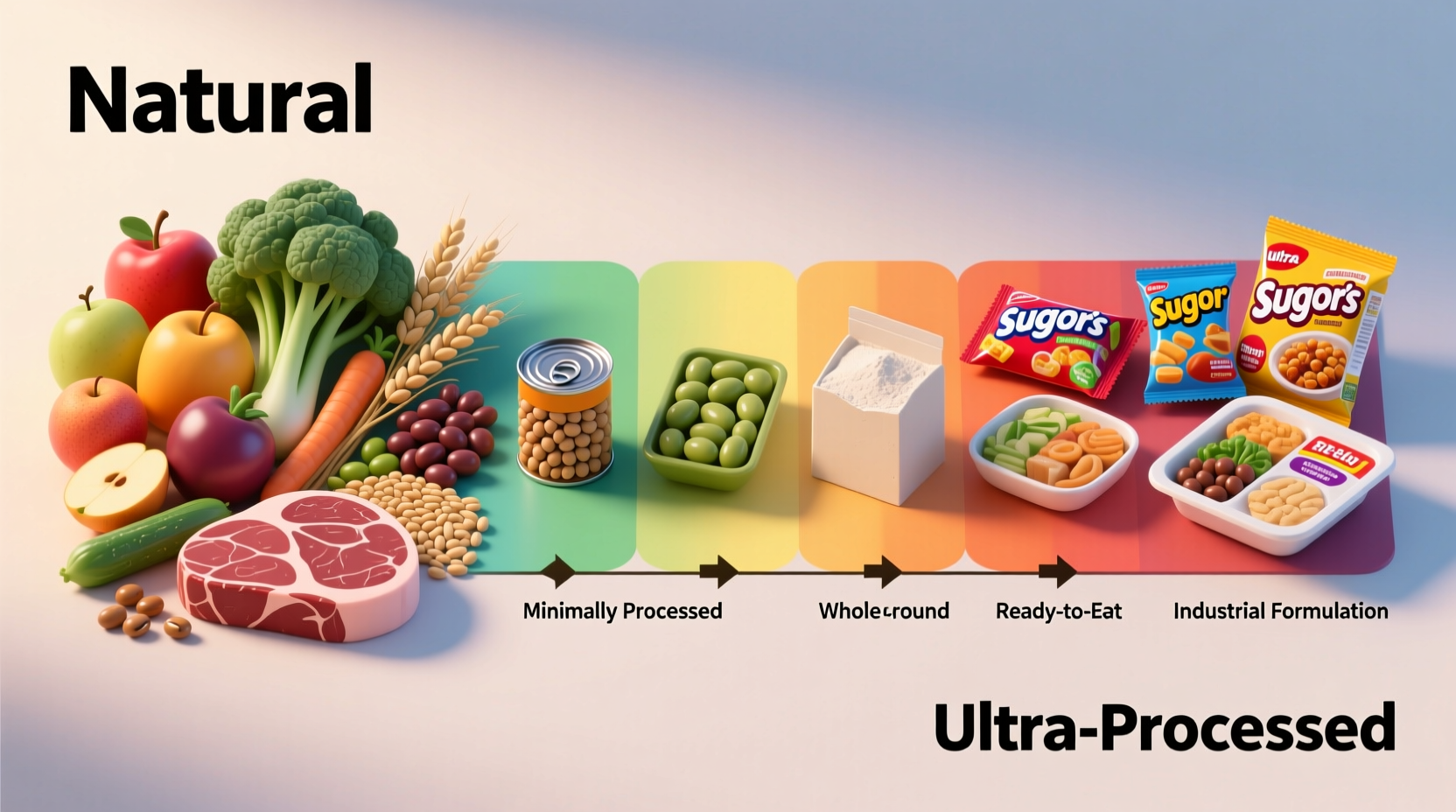Understanding processed foods isn't just about labeling—it's about making informed choices that align with your health goals and lifestyle. Whether you're navigating grocery aisles, meal planning, or simply curious about your food's journey from farm to fork, this guide provides the practical knowledge you need to distinguish between beneficial processing and potentially problematic products.
The Food Processing Spectrum: From Farm to Table
Food processing exists on a continuum, not as a simple binary of "processed" versus "unprocessed." The NOVA classification system, widely referenced by nutrition researchers, categorizes foods based on the extent and purpose of processing:
| Processing Level | Description | Common Examples |
|---|---|---|
| Unprocessed/Minimally Processed | Natural foods with no added substances; may be cleaned, cut, or frozen | Fresh fruits, vegetables, eggs, milk, dried beans |
| Culinary Ingredients | Substances extracted from natural foods for cooking | Olive oil, sugar, salt, honey |
| Processed Foods | Simple products made by adding culinary ingredients to unprocessed foods | Canned vegetables, cheese, freshly baked bread |
| Ultra-Processed Foods | Industrial formulations with multiple additives and little whole food content | Soda, packaged snacks, ready-to-heat meals |
This framework helps consumers understand that not all processing is equal. As the International Food Information Council notes, "Processing can enhance food safety, extend shelf life, and improve nutrient availability"—but the methods and ingredients used determine the nutritional impact.
Why Processing Matters: Benefits and Methods
Food processing serves several legitimate purposes that benefit consumers and food systems:
- Safety enhancement: Pasteurization kills harmful bacteria in milk and juices
- Nutrient preservation: Freezing locks in vitamins shortly after harvest
- Shelf life extension: Canning allows seasonal produce to be available year-round
- Nutritional fortification: Adding vitamins to flour prevents deficiency diseases
- Convenience: Pre-cut vegetables save preparation time for busy households
Common processing techniques include thermal treatments (cooking, canning), mechanical processes (grinding, slicing), preservation methods (freezing, drying), and formulation (combining ingredients). The FDA regulates these processes to ensure safety standards are met across the food supply chain.

Identifying Processed Foods in Your Diet
Reading labels is your most powerful tool for understanding processed foods. Look for these indicators:
Ingredient List Clues
- More than 5-7 ingredients suggests significant processing
- Unfamiliar chemical-sounding names often indicate additives
- Multiple forms of sugar (sucrose, high-fructose corn syrup, maltose)
- Long lists of preservatives, emulsifiers, or artificial colors
Practical Shopping Strategies
Registered dietitians recommend the "perimeter shopping" approach—focusing on fresh produce, dairy, and meat sections around store edges where minimally processed foods dominate. When venturing into center aisles, check for products with recognizable ingredients you could find in your own kitchen.
Health Considerations: Beyond the "Processed Food" Label
Research from the National Institutes of Health shows that ultra-processed foods now constitute over 60% of calories in the average American diet. While not all processed foods are unhealthy, consistent consumption of ultra-processed options correlates with several health concerns:
- Higher risk of obesity and metabolic syndrome
- Reduced nutrient density compared to whole foods
- Potential links to cardiovascular issues when consumed in excess
However, context matters significantly. Canned tomatoes retain lycopene (a beneficial antioxidant) better than fresh ones, and fortified plant milks provide essential nutrients for those with dietary restrictions. The key is understanding what has been processed, how it was processed, and why certain ingredients were added.
Making Smart Choices: A Practical Framework
Instead of labeling all processed foods as "bad," develop a nuanced approach:
- Assess processing purpose: Was it for safety (pasteurization), nutrition (fortification), or convenience (ready meals)?
- Examine ingredient quality: Are additives necessary preservatives or unnecessary flavor enhancers?
- Consider nutritional profile: Does the product provide meaningful nutrients per serving?
- Evaluate frequency: Is this an occasional convenience or dietary staple?
Registered dietitians often recommend the 80/20 approach: base your diet on whole, minimally processed foods 80% of the time, allowing for convenient processed options the remaining 20%. This balanced perspective acknowledges modern lifestyle realities while prioritizing nutritional quality.
When Processed Foods Serve Important Functions
Certain processing methods address critical needs that whole foods alone cannot satisfy:
- Nutrient fortification: Folic acid in grain products has reduced neural tube defects by 35% since mandatory fortification began (CDC data)
- Food safety: Proper canning prevents botulism in low-acid foods like green beans
- Food security: Dried and canned goods provide nutrition during supply chain disruptions
- Dietary accommodations: Gluten-free products enable safe eating for those with celiac disease
The Academy of Nutrition and Dietetics emphasizes that "processed foods play an important role in modern food systems" when chosen thoughtfully. Complete avoidance isn't practical or necessary for most people—discernment is the key.
Building Your Processing Literacy
Developing food processing knowledge takes practice. Start with these actionable steps:
- Choose one processed food category (like bread or dairy) to analyze each grocery trip
- Compare similar products to see how ingredient lists differ
- Learn to recognize common additives and their purposes
- Understand expiration date terminology ("best by" vs "use by")
- Explore traditional preservation methods like fermentation
Remember that processing isn't inherently negative—it's how humans have made food safer, more accessible, and more nutritious throughout history. The goal isn't elimination but informed selection that supports your health goals without unnecessary restriction.











 浙公网安备
33010002000092号
浙公网安备
33010002000092号 浙B2-20120091-4
浙B2-20120091-4